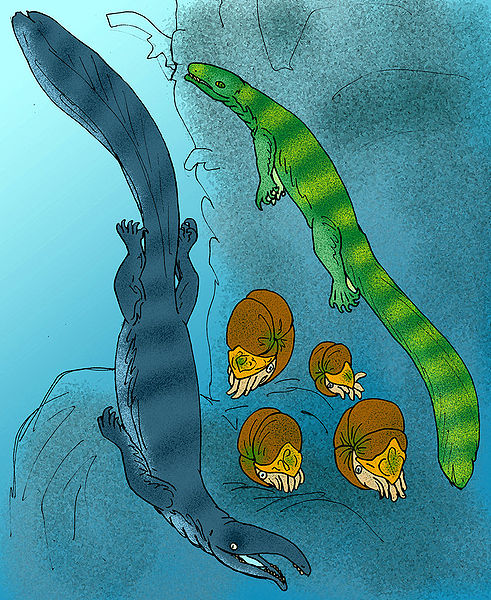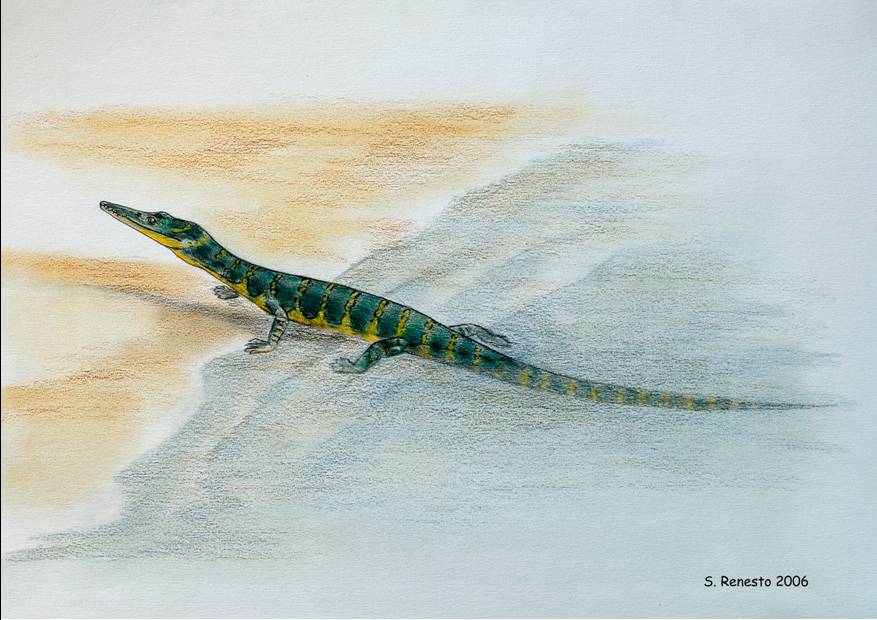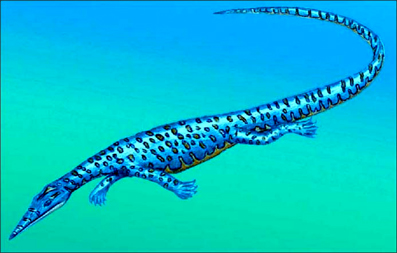[Recent Entries][Archive][Friends][User Info]
Below are the 4 most recent journal entries recorded in the "Сообщество, посвящённое ра" journal:| February 9th, 2012 | |
|---|---|
| 06:41 pm [industrialterro] [Link] |
Nectosaurus Nectosaurus is a genus of marine diapsid reptile which lived during the Late Triassic of what is now California. The type species is N. halinus, described by John C. Merriam in 1905. A 2002 analysis of Nectosaurus classifies it as a thalattosaurian, one of a group of marine reptiles which lived during the Triassic.
Репродукция (справа по борту):
Tags: Вымершие рептилии, Триас, диапсиды, талаттозавры |
| 06:28 pm [industrialterro] [Link] |
Thalattosaurus Thalattosaurus is an extinct genus of marine reptile in the family Thalattosauridae that lived during the Triassic period. It includes two known species. Thalattosaurus was a shellfish-eating reptile around 2 meters (7 ft) in length. Thalattosauridae (From Ancient Greek, meaning "Ocean lizards") is a family of extinct marine diapsid reptiles which lived along the Pacific coast of Late Triassic North America. Specimens of two genera, Thalattosaurus and Nectosaurus, have been found in California. In life, the typical thalattosaur would have resembled a large lizard up to 7 feet in length, half of which being the elongated, flattened tail. Despite resembling lizards, the thalattosaurs' relationships with other diapsids is obscure, with most experts pigeonholing them somewhere between ichthyosaurs and archosaurs. Their closest relative is Askeptosaurus, which was also a marine diapsid from the Triassic. There are several recognized genera of thalattosaurs. The larger Thalattosaurus (which contains two species, T. alexandrae and T. shastensis) fed on shellfish, and the smaller Nectosaurus halinus ate fish. In 1993, Nicholls and Brinkman described Paralonectes merriami and Agkistrognathus campbelli from fossils found at Wapiti Lake, British Columbia, extending the known range of the family to what is now Canada. Thalattosaurs (meaning "ocean lizards") are a group of prehistoric marine reptiles which lived during the mid-late Triassic Period. Some species of thalattosaur grew to over 4 meters (13 feet) in length, including a long, flattened tail used in underwater propulsion. While they bore a superficial resemblance to lizards, the exact relationships of thalattosaurs is unknown; they are widely accepted as diapsids, but experts have variously placed them on the reptile family tree near ichthyosaurs, archosaurs, or Lepidosauromorpha (lizards and their relatives), or as basal neodiapsids. Thalattosaurs have moderate adaptations to marine lifestyles, including long, paddle-like tails and slender bodies. Primitive features of thalattosaurs include the many teeth covering the palate, single-headed ribs, and broad, plate-like coracoid bones. The most unusual features of thalattosaurs are their snouts. Members of one group, the Askeptosauroidea, have long, narrow, pointed skulls. The extended rostra at the end of the skull push back the nostrils so that they are positioned closer to the eye sockets. Most have small teeth but one askeptosauroid, Endennasaurus, is entirely toothless. Members of a second group, Thalattosauroidea, have more distinctive downturned snouts. Clarazia and Thalattosaurus both have snouts that taper into a narrow tip. Most of the snout is straight, but premaxillae at the tip are downturned. Xinpusaurus also has downturned premaxillae, but the end of the maxillae are sharply upturned, forming a notch in the skull. In Hescheleria, Nectosaurus, and Paralonectes, the premaxillae are abruptly downturned at the end of the snout, forming nearly a right angle with the rest of the jaw. In these forms, the end of the snout is a toothy hook separated from the rest of the jaw by a space called a diastema.
Tags: Вымершие рептилии, Триас, диапсиды, талаттозавры |
| 06:22 pm [industrialterro] [Link] |
Askeptosaurus Askeptosaurus is an extinct genus of aquatic reptile related to the thalattosaurian group. Their remains have been found in Italy and Switzerland. Askeptosaurus was a very thin, elongated creature, that probably swam like an eel. Its tail was very long, accounting for around half of the animal's total length of 2 metres (6.6 ft), and its webbed feet would have been well suited for steering itself through the water. Judging from its long jaws, it primarily ate fish. Askeptosaurus probably hunted in deep waters, because it had large eyes suited to conditions of low light. Like ichthyosaurs, it also had a protective bony ring around the eyes, which would have prevented them from collapsing under the immense water pressure of great depths. Этот ящер относится к древнему отряду диапсид - талаттозаврам. Образом жизни напоминал крокодилов и, видимо, почти всё время жизни проводил в море, выползая на сушу только для того, чтобы отложить яйца. У аскептозавра было стройное тело с длинной шеей и вытянутыми зубастыми челюстями. Вероятно, он плавал, волнообразно извиваясь в воде, как змея или угорь, и помогая себе перепончатыми лапами. Кормом ему служила рыба, за которой ящер, судя по всему, мог довольно глубоко нырять. Обитал 220 млн. лет назад в Триасовом периоде в районе современных Италии и Швейцарии. Достигал длины 2 метров и веса в 45 кг.
Tags: Вымершие рептилии, Триас, диапсиды, талаттозавры |
| February 5th, 2012 | |
| 02:18 pm [industrialterro] [Link] |
Endennasaurus Endennasaurus is an extinct genus of thalattosaurian from the Upper Triassic of Italy. Endennasaurs is represented by two specimens, the holotype (5170, Bergamo Museum of Natural Sciences), exposed from the ventral side and lacking the left posterior limb and almost the entire tail, and a second specimen (paratype MBSN 27 in the same collection) exposed from the dorsal side and consisting of few dorsal vertebrae and ribs, part of the pelvic girdle, the right femur and the complete tail. The skull is narrow and elongate, the premaxillae are long, forming anteriorly a pointed rostrum and posteriorly a well developed process; both upper and lower jaw and palatine bones are toothless; frontals are long and narrow, forming most the upper margin of the orbits; occiput lying anteriorly to the quadrate suspension; the upper temporal fenestra is slit like or closed as in thalattosaurs. The neck is rather elongate with vertebrae amphicoelous; there are 12 cervical, 16 dorsal, 2 sacral and up to 67 caudal vertebrae. The trunk is stout and heavy with pachyostotic ribs and massive gastralia. The tail is very long and laterally compressed. The humerus is stout, with expanded and flattened distal head. The femur is slender and about twenty per cent longer than the humerus. There are sligthly reduced ossification in the carpus and in the tarsus. The carpus is represented by the ulnare, intermedium and centrale (the radiale was retained as cartilage) along with the first four distal carpals. Fifth distal tarsal is lost; fifth metatarsal is weakly hooked; phalangeal formula of the pes is primitive: 2,3,4,5,4.As suggested by the general structure of the skeleton Enndennasaurus shows a high degree of adaptation toward aquatic life expressed mainly by the stout distally enlarged humerus, the massive gastralia and the long, laterally compressed tail. Endennasaurus could have moved on land better than the other Thalattosaurs and this reptile probably lived near the coast preying on small organisms. Its long pointed "beak" does not seem an adaptation to catch fishes or to prey on hard shelled molluscs. Endennasaurus preys had to be small animals that did not have a strong shell or exoskelton like some crustaceans and small vertebrates.
Tags: Вымершие рептилии, Триас, диапсиды, талаттозавры |











